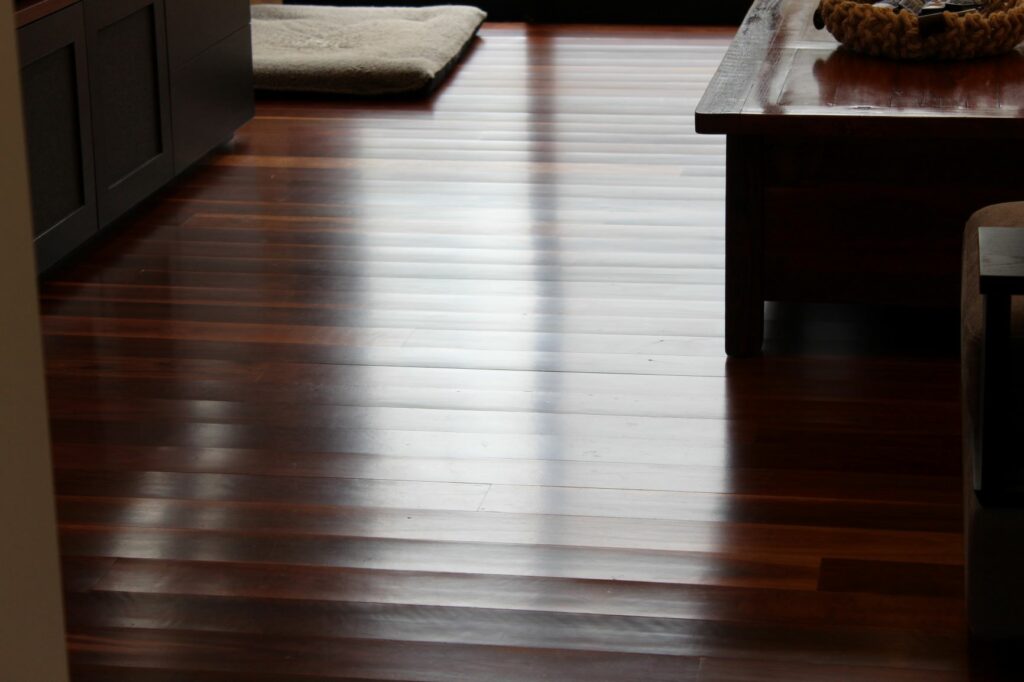Flooring Environments: What to Look For

An example of flooring gapping from shrinking.
Timber flooring offers warmth and visual appeal to a home, bringing some of the beauty of the outdoors inside. Yet no one is happy when a timber floor shows signs of cupping and gapping, or in extreme cases, buckling and tenting. This not only costs you time, but it can also result in major repair costs.
In most cases, timber flooring movement happens soon after shifting into a new home. Why? This causes a change of environment for the timber floor. Timber flooring is kiln dried providing stability but like all timber, it will continue to take up and lose moisture depending on its surroundings and local climate.
Environmental Changes
Changes in humidity can cause movement that alters the surface of the flooring. This can include fine surface checking and small gaps between boards. Sun exposure and fireplaces can also contribute to moisture content variations within a house and causes changes in colour over time as well as board movement.
Check Substrate
It is important to check timber boards for moisture content however, don’t forget to check the substrate. When the flooring substrate is either plywood or particle-board flooring, these wood-based products are still subject to taking up and losing moisture from the subfloor area.
It is important that any difference in moisture content doesn’t exceed 2% between the substrate and floorboards prior to installation. Therefore, check the moisture content not only of the floorboards to be installed but also of the substrate it is laid over.
Drainage to Subfloors
I have seen problem floors on sloping sites or homes situated in gullies, where natural water run-off is directed beneath the subfloor of the home increasing the humidity. These sites should have further drainage provided to divert water away from pooling in the subfloor. In some cases the flooring installation may need to be delayed allowing the subfloor to dry out first. High humidity in subfloors can be addressed by installing mechanical fans that will increase the subfloor ventilation.
In addition, the subfloor is an early section of construction and is often subjected to direct wet weather throughout the building process. This is where early subfloor insulation can help minimise these large differences.
Stabilising Timber
Flooring producers today are very good at minimising the variance of moisture content within a pack of kiln dried timber flooring. They use high manufacturing standards and drying technology to achieve this. This focus on controlling the moisture content is all about enhancing the flooring performance.
Another benefit of close attention to kiln drying allows timber mills to stabilise younger regrowth timbers. In the past old growth timbers inherited greater stability from their size and age. Today regrowth species like Spotted Gum, Ironbark and Blackbutt require more attention at milling and drying because they are younger smaller diameters logs with more sapwood in the cross section.
The Equilibrium Moisture Content (EMC)

EMC measuring a 13.4% moisture content.
The Australian Standard 2796.1 1999 covering Moisture Content MC notes that flooring is to be between 9-14% MC. This range covers the whole of Australia with its diverse climate in different parts of the country. For Melbourne and Canberra cities the average EMC sits close to 12% whereas northern states with higher humidity the average can sit closer to 14%. We receive and dispatch timber flooring with an average moisture content of approximately 10-11%. This range helps us to supply as close to the equilibrium moisture content (EMC) of the local atmosphere of where it is to be used.

An example of cupping in flooring.
There may be situations where a particular vicinity can have a higher or lower EMC than the average 12% and the flooring needs to be acclimatised for a period in the home before laying. This will allow the moisture content of the flooring to adjust and closer match the EMC of the home. The moisture content adjustment can either expand or contract the floorboards slightly before being installed. Aiming to have the new home at an EMC as close to the lived-in EMC as possible.
Understandably this is not that easy when homeowners eventually move in. This is because the use of heaters and air conditioner begin to alter the conditions once again.
Guidelines and recommendations
The Bowens Flooring Installation Guidelines as well the flooring producers’ recommendations are important when evaluating the conditions in which the floor is to be laid. They consider the storage, subfloor ventilation, drainage, dry and level substrates, wet trades, moisture content and flooring acclimatising to ensure that timber flooring movement is minimised.
If you would like more information about timber flooring, installing flooring in your home and general expert information about the building process, feel free to visit the Building Advice section of our blogs.










